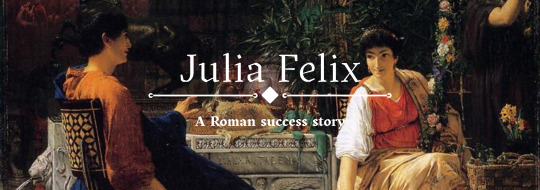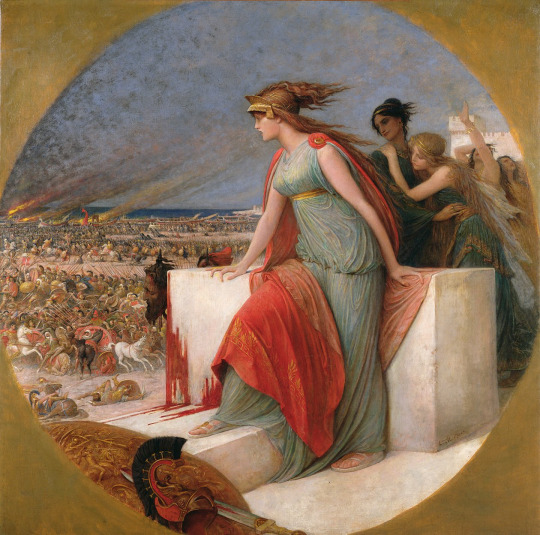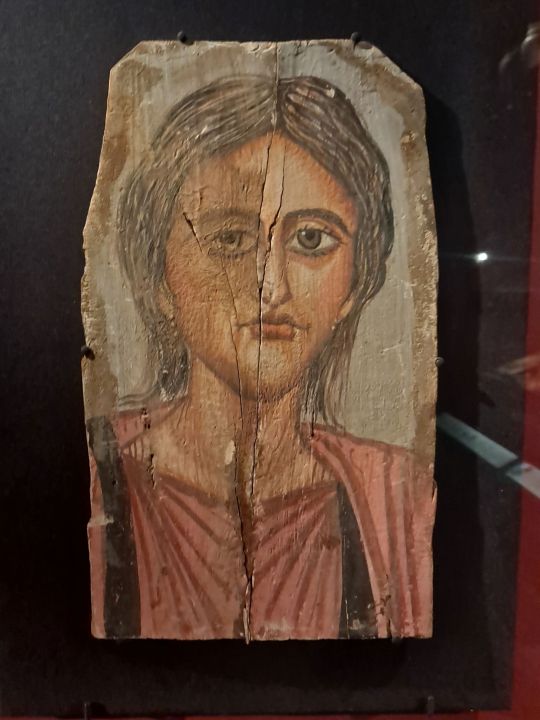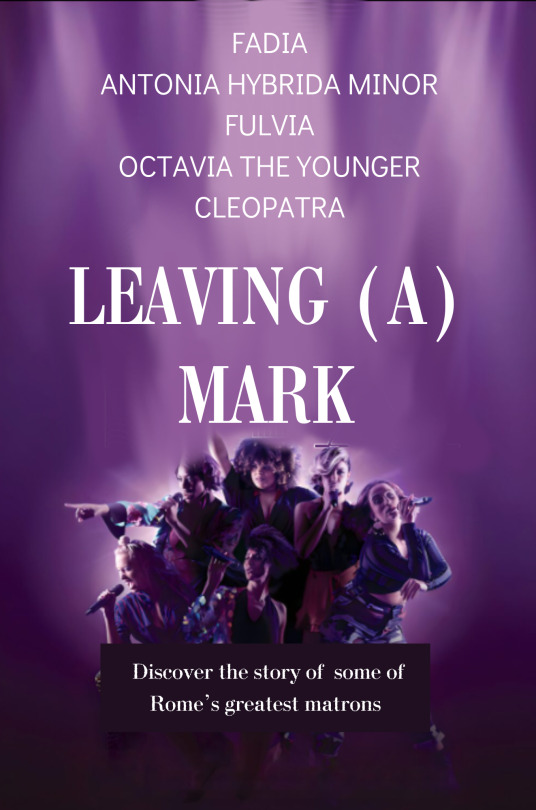#ancient roman women
Text
Women of the Late Republic of Rome & Early Roman Empire on a Modern Date
Cornelia Cinnae
She is absolutely lovely and a sweet soul. The kind of woman you would give up a dowry, your inheritance, and your priesthood for even under the threat of violence. Her ideal date is a tour through a large, public garden. If you end up together, you'll stay together since she inspires that kind of devotion.
Calpurnia
'Stand by your partner' is her motto. Feeling like being Emperor? No problem. She will support you! She'll also finance your date and take you to a public festival to show off your relationship. (Watch out for nearly naked men with crowns.) If she happens to have a weird dream, just listen to her, okay?
Servilia Caepionis
She will take you to a remote, romantic place with candles and gauzy curtains. Dinner AND breakfast will be in bed. The conversation is stimulating, she's beautiful and intelligent, and she knows all the best gossip in town. She will send love notes to your Senate meetings/workplace during the day.
Fulvia Flacca Bambula
She tends to prefer handsome individuals, but once she's loyal to you, she'll be your Ride or Die. (And she doesn't care who has to die to get what you both deserve.) Date wise, Fulvia would enjoy something active and exciting. Take her to a sporting event, a Ninja Warrior competition, an escape room, or go on a hike. She'd love to follow that with a sumptuous dinner and the severed heads of your enemies laid before you in time to enjoy dessert.
Livia Drusilla
Much like Fulvia, this woman is an ideal partner for those who want power. Unlike Fulvia, she's subtle about it. Livia is clever, influential, and could be the perfect politician's wife. Due to her work ethic, she could use a relaxing spa date that includes a massage. Don't worry, the poisoning thing is only a rumor. (And doesn't everyone deserve better than Gaius Julius Caesar Octavianus?)
Octavia Minor
An absolute sweetheart, she is the kindest of the bunch and "a marvel of womankind." Octavia loves the arts, so heading to an art museum, a play, or even a poetry reading would be appreciated. This woman will literally go to the ends of the earth for you--including Athens after you finish a terrible military campaign. She's the complete package, but keep two things in mind. One: she comes with children and most likely will adopt more. Two: she also comes with her brother Octavian/Augustus as a possible new in-law.
Porcia Catonis Brutus
Affectionate and intelligent, she's a deeply loyal choice. She will remind you of your good qualities and keep you on the correct path so long as you trust her with your burdens. She will even support your need for a political assassination. Her ideal date may actually be a masquerade ball. You get to dress up, dance, wear masks, and it would really be a perfect time for a side meeting of similarly inclined couples. (Possibly Junia Tertia could come with her partner, for instance.)
Clodia Metelli
Her ideal date involves listening to you read her poetry and then a nice picnic outside. She enjoys discussing philosophy as well as every political player in town. She's charming and experienced, just don't expect it to last or you'll end up like Catullus.
Cleopatra VII Thea Philopater
Her charm is famous throughout multiple lands and her wisdom and prowess equally lauded. Not only is she a brilliant politician, she is interested in science, the arts, and can speak over seven languages. Cleo is an amazing partner and her love is worthy of fighting a civil war over. Seriously. As far as dates, she would enjoy a scenic, luxury cruise on the river. Just beware that once you have her in your life, you will be unwilling to live without her.
Julia the Elder/Julia Caesaris filia
She is a very passionate woman who loves literature, culture, and a good nightlife. If you take her on a date, expect to either go for a night of pub crawling or to a fancy cocktail party complete with glittering outfits. Julia wants a good time, but her kindness and empathy are famous, as are her quick wit and rebellious ways. She is worthy of getting yourself exiled or worse over.
Type of post originated by @just-late-roman-republic-things
So many wonderful women to choose from, it was difficult! I just didn't want to have too many choices... Maybe a part two? Junia Tertia, Tullia, Pompeia, Atia, Julia Antonia, Attica are just a few others I wanted to include.
Also Cleopatra was involved with the Late Republic of Rome so I included her even if she is obviously not Roman herself.
Please reblog if you want and definitely vote for the girl bosses.
#ancient roman memes#classics memes#ancient roman women#i wrote woman romen twice. should not be doing this without sleep#women's history#ancient women#ancient Ptolemaic women#ancient rome#ancient egypt
71 notes
·
View notes
Text
I love you people going into "useless" fields I love you classics majors I love you cultural studies majors I love you comparative literature majors I love you film studies majors I love you near eastern religions majors I love you Greek, Latin, and Hebrew majors I love you ethnic studies I love you people going into any and all small field that isn't considered lucrative in our rotting capitalist society please never stop keeping the sacred flame of knowledge for the sake of knowledge and understanding humanity and not merely for the sake of money alive
#classics#mythology#ancient greek mythology#ancient roman mythology#comparative literature#latin#hebrew#ethnic studies#fuck capitalism#communism#i love my useless degree idc#academia#university#dark academia#Greek#philosophy#liberal arts#humanities#women and gender studies#cultural anthropology
41K notes
·
View notes
Text
yk what I love? that the first text we have written by a woman in England was a Roman woman inviting her best friend to her birthday
#the first words written by a woman were ones of love#she called her 'my dearest soul'#i just love women#so much#roman empire#vindolanda#hadrians wall#ancient history#history#archaeology#art history
2K notes
·
View notes
Text
Which Underrated Woman from History are You?
Finally got around to making a uquiz featuring six of my favourite women from history! You can either get someone from the French Revolution, Roman Republic (I know, how unexpected!) or from 1700s/early 1800s.
Featuring scientists, writers, politically active icons and a few poets whose lives were intertwined with theirs, as a treat!
Enjoy and thanks everyone for sharing! ✨
#frev#french revolution#ancient rome#roman republic#history#tagamemnon#uquiz#tumblr quiz#which are you?#age of enlightenment#1700s#1800s#romantic era#18th century#19th century#émilie du châtelet#fulvia#clodia#mary shelley#ada lovelace#lord byron#literature#women's history#uquiz link#personality quiz#quiz tag#percy bysshe shelley#lucile desmoulins#camille desmoulins#catullus
256 notes
·
View notes
Text

"Here’s what we know about Julia Felix: she lived in Pompeii from at least 62 CE. She was possibly illegitimate but was definitely not a member of the social and cultural elite. She worked for a living setting up and running a very interesting business and, by 79 CE, she had planned to shift her focus from managing a business to owning property. We know all these things because twentieth-century excavations at her business uncovered an advert, carved in stone and attached to the external wall of her huge building. It reads:
"To rent for the period of five years from the thirteenth day of next August to the thirteenth day of the sixth August, the Venus Bath fitted for the nogentium, shops with living quarters over the shops, apartments on the second floor located in the building of Julia Felix, daughter of Spurius. At the end of five years, the agreement is terminated."
This find illuminated the building it was attached to, bringing what otherwise looked like a very large anonymous domestic house into dazzling focus. With this description of the purpose of each room written by the owner herself, archaeologists and historians could see the site through a whole new lens and they realised that they had discovered a Roman entertainment space for the working middle classes. It is, so far, a completely unique find and it is magnificent. It offers us, as modern viewers, two amazing things: a little glimpse into the lives of the commercial classes of the Roman Empire who are so often completely and utterly invisible, and a brutal reminder that so much of what we ‘know’ about Roman women in the Roman world comes from rules concerning only the most elite.
We’ll do that second part first, because it’s the least fun. Roman written and legal sources are pretty universal in their agreement that although women could own property, they could not control it; they had no legal rights, could not make contracts and were to be treated as minors by the legal system for their entire lives. In order to buy or sell property women required a male guardian to oversee and sign off on any transactions. This is a basic truism of women in the Roman Empire, repeated ad nauseum by sources both ancient and modern including me, and it is undermined by Julia Felix’s rental notice.
The rental ad makes it pretty clear that Julia Felix is the owner-operator of a business complex including public baths, shops and apartments (there’s more too, as we’ll see), and she doesn’t seem to require anyone else to help her rent it out. She names her father – sort of; ‘Spurius’ might just mean that she is illegitimate – but this is effectively a surname, a personal identifier to differentiate her from other Julia Felixes in the area. It doesn’t mean her father was involved. Furthermore, the use of her father’s name as an identifier suggests that Julia didn’t have a husband and was either unmarried or widowed in 79 CE. The strong implication of her advert is that Julia Felix was an independent lady, a honey making money and a momma profiting dollars who could truthfully throw her hands up to Destiny’s Child.

We will never know if Julia escaped the flames and choking ash of 79 CE, fleeing as it swallowed her business and her home, but one discovery, made on 28 January 1952, suggests that she didn’t. The archaeologists, led by Amedeo Maiuri, uncovered on that day the skeleton of a woman who had fallen while running across the garden during the disaster. It’s clear this fallen woman was well off, because she was wearing a lot of gold jewellery. She carried four gold half-hoop earrings and wore four gold rings. Two of these rings were particularly expensive; both contained a red carnelian gem, one carved with a figure of Mercury, the other with an eagle. Around her neck she wore a necklace of gold filigree, dotted with ten pearls and hung with a green pendant. Someone stole both the necklace and earrings from the Pompeii Antiquarium in 1975 and no one, somehow, had ever bothered to photograph them so all we have are descriptions but the rings that survive are fine and expensive. The woman who wore them – was wearing them when she died – had real money to buy these objects and the woman who wore them did'nt leave Pompei in time.
Moreover, when she was found it was clear that at the moment of her death she was heading not towards the street or towards safety, but towards the shrine to Isis in the garden where all the most valuable possessions were kept. The valuable possessions that Julia Felix grafted for and maybe couldn’t bear to leave behind. There’s no way to tell whether this skeleton is Julia Felix, whether these bones once stood and looked at the plots of land Julia bought and made plans, or whether they belong to a looter or a chancer or someone just caught out. But it’s nice to pretend that Julia Felix, who shaped the city’s roads around her dream and offered respite and luxury to workers and made a tonne of money doing it, died and was buried with the place that still bears her name."
A Rome of One's Own: The Forgotten Women of the Roman Empire, Emma Southon
#julia felix#historyedit#history#women in history#ancient rome#pompei#businesswomen#italy#italian history#roman history#roman empire#1st century#historyblr#historical figures
208 notes
·
View notes
Text

Battle Scene by Lionel Royer
#lionel noël royer#lionel royer#art#battle#ancient#antiquity#classical#classical antiquity#neoclassical#neoclassicism#ancient world#europe#european#war#history#cavalry#soldiers#ancient greece#ancient greek#ancient rome#ancient roman#goddess#noblewoman#women#woman#fortress#battlefield#ships#horses
186 notes
·
View notes
Text


Inspired by the recent excavations and new frescos at Pompeii
Our friend Papilio the Painter from ‘Amarantus and his Neighbours’ (Caroline Lawrence and CSCP) for Dr Sophie Hay
With apologies to the painters of Pompeii
PHOTO BBC/TONYJOLIFFE
#pompeii#ancient greek women#tagamemnon#greek mythology#greek myth#illustration#greek myth comix#trojan war#comic#myth comic#artistic choices#fresco#excavationss#scavi di pompei#roman history#painter#papilio the painter
171 notes
·
View notes
Text
This might just be a *me* thing, but I do find it kind of fascinating that almost every Feminist Greek Myth Retelling seems compelled to flatten Helen into a two-dimensional basic-bitch with no guilt or remorse for her actions despite the fact that self-loathing for her own beauty, a feeling of a lack of agency in the face of Aphrodite's whims and a complicated affection for and loyalty to both the Greeks and the Trojans are all major characteristics of hers in both The Odyssey and The Iliad. I'm sure this has nothing to do with the dynamics of modern feminism and patriarchy whatsoever.
#like. guys. if there's any character who's just BEGGING for a retelling from their POV other than Briseis and Lavinia#(which have already been done)#it is Helen#she is the literal quintessence of 'woman relegated to object in a competition between men'#and yet she still somehow has a more nuanced character in stories written by ANCIENT GREEK MEN (gestures generally at Athens)#then she does today#what are you people doing#classics#greek mythology#should i tag the books im referring to? yes. i will actually.#the song of achilles#a thousand ships#silence of the girls#the women of troy#(just realised that Lavinia technically isn't a creation by Greek men but snsyshdjeuds#Grecco-Roman mythology / Aeneid follows Iliad / you get my point)#anyway come at me i'm ready to be burned at the stake#oh shit i also forgot#the penelopiad
92 notes
·
View notes
Text

Hersilia Separating Romulus and Tatius, Guercino, 1645
#art#art history#Guercino#Giovanni Francesco Barbieri#mythological painting#Roman mythology#Ancient Rome#Romulus#Sabine Women#Baroque#Baroque art#Italian Baroque#Italian art#17th century art#oil on canvas#Louvre#Louvre Museum#Musee du Louvre
108 notes
·
View notes
Text
Time Travel Question 53: Medievalish and Earlier
These Questions are the result of suggestions a the previous iteration. This category may include suggestions made too late to fall into the correct earlier time grouping. In some cases a culture lasted a really long time and I grouped them by whether it was likely the later or earlier grouping made the most sense with the information I had.
Please add new suggestions below if you have them for future consideration. All cultures and time periods welcome.
#Time Travel#Early Modern#Middle Ages#Medieval Art#Christina the Astonishing#Christina Mirabilis#Women in History#Art History#Historical Figures#Cahokia#Voynich Manuscript#Hypatia of Alexandria#Indus Valley Civilization#Legio nona Hispana#Roman Empire#Ancient World#Bees#Extinct Species#The Bible#Astrophysics#The Moon#Pyramids#The Great Pestilence#History of Medicine#Historical Disease#The Black Death#Yersina Pestis#The Second Great Pandemic
38 notes
·
View notes
Text

Mummy portrait
* Roman Egypt
* Medelhavsmuseet, Stockholm
Stockholm, November 2023
70 notes
·
View notes
Text

Vestal Virgins OC’s.
I recently studied the little that is known about these priestesses, and they really interested me. In particular, the fact that in most paintings they are usually depicted as a group of young women, although logically this cannot be so. The service life of a Vestal is 30 years, during the first 10 she studies, then 10 years serves and the next 10 teaches the younger ones. That is, if they were all the same age, then after finishing the service, it would be necessary to hire six children)
37 notes
·
View notes
Text
Cleopatra & Amanirenas versus the Romans

The Nile Valley queens Cleopatra of Egypt and Amanirenas of Kush are up against the wrath of the Roman legions! Can our heroines fight their way out of this predicament and defeat one the mightiest armies in the first century BC?
This is of course a fictional “alternate history” scenario I did for the sheer fun of it, but I really like the idea of Cleo and Amani teaming up against Rome. One wonders whether Cleopatra’s Egypt might have held up a little longer with more Kushite support…
#cleopatra#ancient egypt#egyptian#kemet#amanirenas#ancient kush#kushite#nubian#african#black women#women of color#warrior women#ancient rome#roman#legionaries#fantasy#alternate history#digital art#art#illustration
38 notes
·
View notes
Text

You've heard about Cicero: The Roman Musical. Now get ready for Six-style musical about the wives of Mark Antony! (also featuring Curio)
Featuring but not limited to:
Antonia Minor's steamy duet with Dolabella
Fulvia's epic battle-cry rap number, including a verse based on Octavian's terrible poem
Octavia's heartfelt power ballad about desperately trying to keep the Octavian-Mark Antony alliance together while looking after all the children (while simultaneously refusing to allow other people to walk all over her)
Cleopatra singing about her political ambitions, comparing JC and Mark Antony, defending herself against her portrayal in Rome & in modern media
Also featuring a song/rap number based on Cicero's second philippic because it needs to be there!! Mark Antony climbing in through the roof, possibly in a stola, Curio and his dad is there ---
Some kind of ensemble song with the wives addressing the audience based on Shakespeare's Friends, Romans, countrymen speech
you see my vision, right?
Also yes, I'm aware there's six of them on the poster. One of them is Curio perhaps. Also, graphic design is my passion, can you tell?
#ancient rome#roman republic#roman empire#tagamemnon#history shitposting#history memes#mark antony#julius caesar#cleopatra#fulvia#dolabella#octavia#octavia the younger#octavian#augustus#six the musical#musical memes#marcus antonius#william shakespeare#cicero#marcus tullius cicero#curio#roman history#women's history#fadia#antonia minor
49 notes
·
View notes
Text
"According to Roman sources, emperors such as Nero and Domitian were fond of throwing lavish celebrations featuring female gladiators as novelty acts. The Roman historian Cassius Dio wrote of a days-long festival Nero held in honor of his mother in 59 where upper-class men and women “drove horses, killed wild beasts, and fought gladiators, some willingly and some sore against their will.” Roman historian and politician Tacitus referred to Nero’s female gladiators as feminarum, a term reserved for upper-class women, writing that “many ladies of distinction, however, and senators, disgraced themselves by appearing in the amphitheater.”
In 66, Nero sponsored more gladiatorial games featuring Ethiopian women, wrote Dio. And in 88, Emperor Domitian held games that again featured female gladiators, wrote biographer and historian Seutonius.
Sources also wrote of venatrices, female beast hunters, appearing in the Colosseum’s 100 days of opening games in 80. Venatrices took down stags, boars, and even lions with spears and bows, says Potter. Whereas female gladiators likely fought other women to first blood in single combat, explains Potter. Contrary to popular belief, fighting to the death was rare in gladiatorial games: Sponsors considered gladiators expensive, long-term investments.
Even though many Romans disapproved of female gladiators, people went wild for them in the arena. “We do know that some of the [female gladiator] fights took place in mid-afternoon, and that’s not the time for the novelty acts or the comedies or the executions,” says Philip Matyzask, an author, historian, and professor at the University of Cambridge. “That’s the time for the premier gladiator fights. So they were treated as serious professional bouts.”
The very existence of female gladiators complicates the understanding of Roman gender roles. Many believe Roman women were docile, modest, meek, and subservient to the men in their lives. But “Roman women wielded much more influence in society than many people out in the public think,” says Coleman. Roman women could be independent benefactors (funding the construction of buildings, temples, and social programs), own property, and divorce their husbands.
“I think we develop a better understanding of our own culture by close study of another,” says Potter, and studying female gladiators illuminates the “latent sexism in the way we view women,” both today and in antiquity.
Rome’s female gladiators are just one offshoot of women’s long, often-forgotten history as warriors. “Women have fought in nearly all conflicts and wars throughout history, from the war of Troy until today,” says Manas. Rome’s female gladiators were the women warriors of their time—redefining societal expectations of what women were and are capable of."
#history#women in history#women's history#ancient rome#roman history#ancient world#ancient history#female gladiators#gladiatrix#warrior women#1st century#3rd century#roman empire#historical figures
108 notes
·
View notes
Text

Christian Dirce by Henryk Siemiradzki
#henryk siemiradzki#art#nero#emperor#christian#dirce#ancient rome#roman empire#roman#romans#antiquity#martyr#martyrs#greek mythology#euripides#bull#horns#women#reenactment#queen of thebes#enactments#history#europe#european#entourage#lictors#fasces#architecture#rome
94 notes
·
View notes